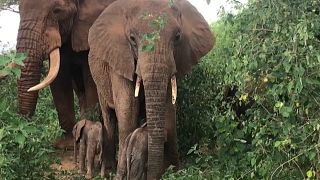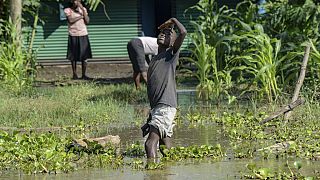Kenya
Two-month-old male and female elephant twins born to 39-year-old mother Paru at the 392 square kilometres Amboseli National Park situated 240 kilometres South-East of Nairobi, Kenya -- along the border of Tanzania, are staying close to their herd of 40 elephants.
Kenneth Ole Nashu, Senior Warden of Amboseli National Park.
"There are two twins and then there is another younger (older) sister moving alongside with them. This means that it takes care also when the mother is also grazing or grossing (strolling) then the younger sister takes care of the twins. You can see them moving together in three. I think you have seen them moving they are three. So there is the big one and then there are twins."
Indeed, the sibling pair -- a rare occurrence, according to the Kenya Wildlife Service (KWS), keep close to their beloved mother and older sister for safety as they take on their budding new lives.
Nashu shares that the last time the park saw an elephant twin birth was in 1980 when babies Equinox and Eclipse were born.
"For the last 38 years, this park experienced a very unique scenario whereby we have an elephant giving birth to twins that was around 1980 and then this time again round we had Paru (referring to the name of the mother elephant) giving birth again twins. This is a very unique scenario in terms of conservation particularly in the elephant population."
Since birth, one of the new babies of the twin set has a wound on its back which conservationists say has been steadily healing.
"We are really proud and we are now monitoring and we are ensuring that the babies are quite in good health. Also, our vets are monitoring and ecological monitoring systems are put in place to ensure that this mother is well safe and also monitoring when she goes outside (the park) we also monitor it," the senior warden gushes.
Kenya's Amboseli National Park is just next to Mount Kilimanjaro and is a popular visitor attraction because of its huge number of elephants.
There are 1,600 elephants at the park which are grouped into 58 families.
Each of the families has a two-letter code that is used for identification for instance AA, AB, CA.
Moreover, the name of each family member begins with the first family letter.
The male and female twins were delivered at the end of May during the rainy season by their mother who belongs to the PA family, a herd of 40 elephants.
In 2017, 10 elephant calves died at Amboseli National Park due to drought and the recent birth of twins is considered great news.
The wardens at the park have since put measures in place to ensure that the elephants are safe.
Mum, Paru has an aforementioned older female calf who is acting as the perfect big sister to the twins who are settling into their life as the park's youngest elephant residents.
Norah Njiraini, Amboseli Trust for Elephants, explains:
"We study the behaviour of the elephants and we know by name all the elephants in Amboseli. They are 1,600 (number of elephants in total), fifty-eight (58) family units. Talking about family, a family consists of cousins, grandmothers, sisters stay together the rest of their lives and the oldest female she is the boss of the family otherwise there is no 'papa' in the family. The males leave the families when they are ten (10) to fifteen (15) years old."
An elephant pregnancy can last about 22 months. Due to the huge size of an elephant, the development of the foetus in the mother's womb is slower and it takes approximately 660 days.
The Amboseli National Park has also taken steps to curb incidents of poaching by involving 300 scouts from the local community who assist the wardens in guarding the elephants.
The Kenya Wildlife Service recently carried out an aerial census of elephants in the park.
Julius Kimani, Kenya Wildlife Services director explains the approach to elephant numbers.
"We are trying to establish the number of wildlife species, the big mammals that we have in the ecosystem because as you have heard from our chief scientist here it is not possible to manage what we cannot count; what we cannot measure so the objective today is to establish the number of the big animals that we have in this ecosystem so that we can be able to establish the management strategies. We want to know how many are in the parks, how many are outside the park."
Conflict between humans and wildlife has also been an issue which the conservationists hope to mitigate through the aerial census.
"When they move outside the park there is quite a lot of human-wildlife interactions and we also need to manage that so we are doing an ecosystem-wide aerial count because that is the most comprehensive kind of count that we are able to do. It is expensive but it is important," adds Kimani.












00:51
Why is Botswana threatening to send herdes of elephants to Germany?
02:29
Africa's birds of prey under threat of extinction
02:30
Kenya: After a successful relocation, 21 black rhinos start journey to a new home
00:49
Ivory Coast president rewards football team for their AFCON win
01:53
Madagascar celebrated at London orchid festival
02:43
Kenyan beekeepers turn to bee venom as lucrative alternative